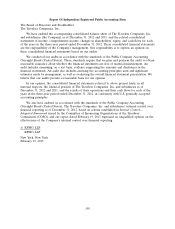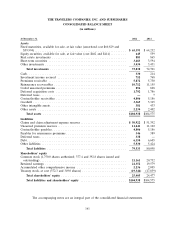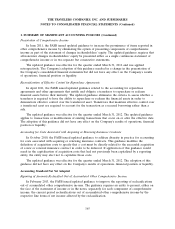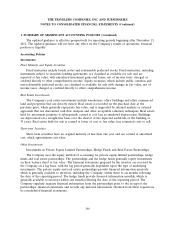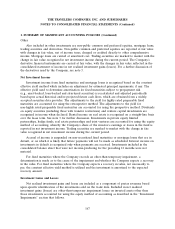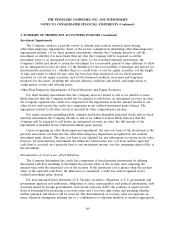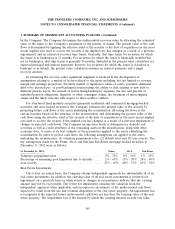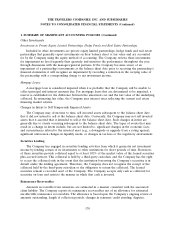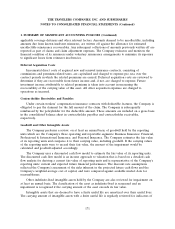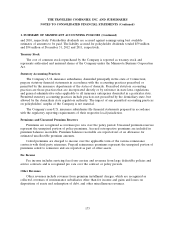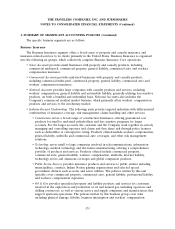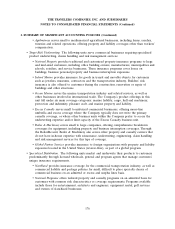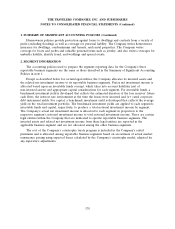Travelers 2012 Annual Report Download - page 180
Download and view the complete annual report
Please find page 180 of the 2012 Travelers annual report below. You can navigate through the pages in the report by either clicking on the pages listed below, or by using the keyword search tool below to find specific information within the annual report.THE TRAVELERS COMPANIES, INC. AND SUBSIDIARIES
NOTES TO CONSOLIDATED FINANCIAL STATEMENTS (Continued)
1. SUMMARY OF SIGNIFICANT ACCOUNTING POLICIES (Continued)
Investment Impairments
The Company conducts a periodic review to identify and evaluate invested assets having
other-than-temporary impairments. Some of the factors considered in identifying other-than-temporary
impairments include: (1) for fixed maturity investments, whether the Company intends to sell the
investment or whether it is more likely than not that the Company will be required to sell the
investment prior to an anticipated recovery in value; (2) for non-fixed maturity investments, the
Company’s ability and intent to retain the investment for a reasonable period of time sufficient to allow
for an anticipated recovery in value; (3) the likelihood of the recoverability of principal and interest for
fixed maturity securities (i.e., whether there is a credit loss) or cost for equity securities; (4) the length
of time and extent to which the fair value has been less than amortized cost for fixed maturity
securities or cost for equity securities; and (5) the financial condition, near-term and long-term
prospects for the issuer, including the relevant industry conditions and trends, and implications of
rating agency actions and offering prices.
Other-Than-Temporary Impairments of Fixed Maturities and Equity Securities
For fixed maturity investments that the Company does not intend to sell or for which it is more
likely than not that the Company would not be required to sell before an anticipated recovery in value,
the Company separates the credit loss component of the impairment from the amount related to all
other factors and reports the credit loss component in net realized investment gains (losses). The
impairment related to all other factors is reported in other comprehensive income.
For equity securities (including public common and non-redeemable preferred stock) and for fixed
maturity investments the Company intends to sell or for which it is more likely than not that the
Company will be required to sell before an anticipated recovery in value, the full amount of the
impairment is included in net realized investment gains (losses).
Upon recognizing an other-than-temporary impairment, the new cost basis of the investment is the
previous amortized cost basis less the other-than-temporary impairment recognized in net realized
investment gains (losses). The new cost basis is not adjusted for any subsequent recoveries in fair value;
however, for fixed maturity investments the difference between the new cost basis and the expected
cash flows is accreted on a quarterly basis to net investment income over the remaining expected life of
the investment.
Determination of Credit Loss—Fixed Maturities
The Company determines the credit loss component of fixed maturity investments by utilizing
discounted cash flow modeling to determine the present value of the security and comparing the
present value with the amortized cost of the security. If the amortized cost is greater than the present
value of the expected cash flows, the difference is considered a credit loss and recognized in net
realized investment gains (losses).
For non-structured fixed maturities (U.S. Treasury securities, obligations of U.S. government and
government agencies and authorities, obligations of states, municipalities and political subdivisions, debt
securities issued by foreign governments, and certain corporate debt), the estimate of expected cash
flows is determined by projecting a recovery value and a recovery time frame and assessing whether
further principal and interest will be received. The determination of recovery value incorporates an
issuer valuation assumption utilizing one or a combination of valuation methods as deemed appropriate
168


